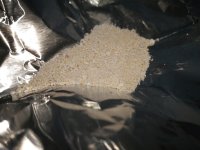So Zn-ing a raw rue tea is a nono.
Goes for mimo too?
This particular batch of mimo yielded consistently, in weight, 50% white fluffers and 50% heavy oil. This oil submitted to 2x Zn-ing turned into nice fluffers with only a very tiny loss in weight which made me suspect it must have been n-oxides mostly.
I know mimo has been reported to have no n-oxides, and previous batches mimo did not do that heavy oil trick as such, and then there is the polymorphism thing, but why did the Zn do it's trick so well? I don't want to deviate to this but was just wondering if the Zn trick could be done on mimo in the wood-in-liquid-acid stage? Or would this be not advised because of same reasons as rue: too many '?' components in that stage that could reduce as well.
If I read Pitubo's adds it would be a nono too.
Yet the difference here with mimo compared to rue is that the mimo gets pulled with a non polar, that stage does not happen with rue.
Goes for mimo too?
This particular batch of mimo yielded consistently, in weight, 50% white fluffers and 50% heavy oil. This oil submitted to 2x Zn-ing turned into nice fluffers with only a very tiny loss in weight which made me suspect it must have been n-oxides mostly.
I know mimo has been reported to have no n-oxides, and previous batches mimo did not do that heavy oil trick as such, and then there is the polymorphism thing, but why did the Zn do it's trick so well? I don't want to deviate to this but was just wondering if the Zn trick could be done on mimo in the wood-in-liquid-acid stage? Or would this be not advised because of same reasons as rue: too many '?' components in that stage that could reduce as well.
If I read Pitubo's adds it would be a nono too.
Yet the difference here with mimo compared to rue is that the mimo gets pulled with a non polar, that stage does not happen with rue.


 :twisted:
:twisted: 